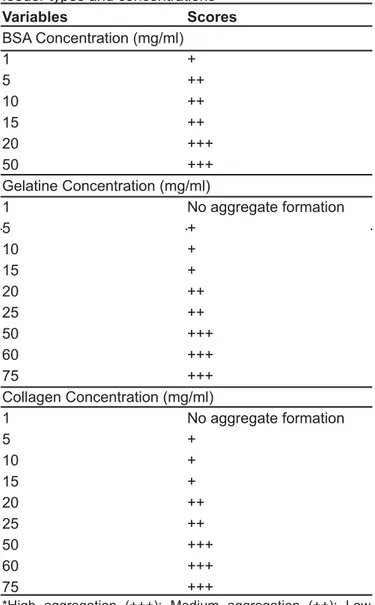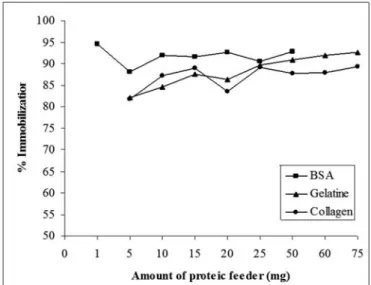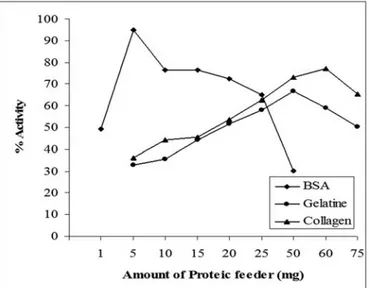INTRODUCTION
For the last 50 years, investigations about enzymes were devoted to the improvement of various carrier bound immobilised enzymes with the aim of facilitating their use in continuous processes [1, 2]. Enzyme immobilization can accomplish developed enzyme performance such as activity, stability and selectivity [3, 4].
There is no definite method of enzyme immobilization. Successful immobilization is depending on selection a suitable carrier, conditions (pH, temperature, medium) and enzyme. Because of this, the design of carrier-bound immobilised enzymes relies largely on laborious and time-consuming trial and error experiments [5]. So, there is a new interest in carrier-free immobilised enzymes such as cross-linked enzyme aggregates (CLEA) [6].
CLEAs were added to the immobilised enzymes techniques more recently [6]. By altering properties that effect the proximity of soluble enzyme
HACETTEPE JOURNAL OF BIOLOGY AND CHEMISTRY Research Article
Hacettepe J. Biol. & Chem., 2008, 36 (4), 313-318
Proteic Feeder Effect on Glucose Oxidase Aggregates Formation
Yasemin İspirli, Hakan Ayhan*
Muğla University, Faculty Science and Art, Department of Chemistry, Biochemistry Division, Muğla, Turkey.
Abstract
In this study, it is aimed to prepare cross-linked glucose oxidase (GOD) aggregates by using different proteic feeders. Bovine serum albumin (BSA), gelatine and collagen were used separately as proteic feeders in the aggregate pre-paration process. The initial enzyme concentration was kept constant as 0.05 mg/ml. The amount of BSA varied from 1 to 50 mg and the amount of gelatine and collagen were in the range of 5- 75 mg. A cross-linker, glutaraldehyde (2 % v/v) has been used in order to form GOD aggregates with proteic feeder. The highest immobilization efficiency was found when BSA feeder was used. Activities of both free and immobilised GOD were obtained by measuring the amount of hydrogen peroxide formed from glucose conversion, by using spectrophotometer. The maximum activities were obtained at following proteic feeder amounts: BSA 5 mg, collagen 60 mg, gelatine 50 mg. Kinetic parameters of native and immobilised enzyme have been calculated by using Lineweaver-Burk plots in the substrate range of 0.01-1 M . The maximum reaction rates for free and immobilised enzyme with different proteic feeders, BSA, gela-tine and collagen were calculated as 66.29, 12.22, 9.29, 4.53 mM/min-1, respectively. The corresponding saturation
constants of systems with the maximum activity were 7.9, 11.37, 22.58, 33.6 mM, respectively.
Key Words: Cross-linked Glucose Oxidase aggregates, Proteic feeder, Bovine Serum Albumin, Gelatine, Collagen.
* Correspondence to: Hakan Ayhan
Muğla University, Department of Chemistry, Biochemistry Division, 48170 Muğla, Turkey.
Tel: +90252 211 1506 E-mail: hayhan@mu.edu.tr
Special Issue for National Affinity Techniques & BIOMED 2008
---'-molecules, they can be made to form physical aggregates after cross-linking. For example, it is possible to form aggregates by changing the hydration state of enzyme molecules or changing the electrostatic constant of the solution by adding appropriate aggregations agents [7]. Enzymes molecules were precipitated as insoluble aggregates with native enzyme conformation and these insoluble aggregates can be cross-linked by bifunctional cross-linkers [6]. The formation of CLEAs attributed to both intermolecular and intramolecular crosslinks introduced in the protein molecules [8,9,10].
CLEAs can be prepared with greater mechanical stability and tailor-made size. In principles, CLEAs are applicable to any reaction system, reactor configuration and reaction medium. Recently studies enclose the development of CLEAs of abroad range of enzymes, size control, new aggregations methods, new precipitants and new cross-linkers to construct a flexible technology platform for designing robust CLEAs for broad applications [11].
Glucose oxidase is used for production of gluconic acid in industry and in foods as a protective material. The most important usage is diagnosis for diabetes mellitus.
In this study, glucose oxidase from Aspergillus Niger was used. The enzyme glucose oxidase has been converted to physical aggregates by adding different proteic feeder (with varying amounts) separately. Cross-linking was performed with constant glutaraldehyde amount. The effect of proteic feeder type and concentration on the immobilization efficiency and activity of GOD aggregates were studied. Kinetic parameters of free and immobilised system were calculated.
MATERIALS AND METHODS
Chemicals
Glucose Oxidase from Aspergillus niger (E.C.232-601-0), glutaraldehyde (GA), bovine serum albumin (BSA), gelatine, collagen and glucose were purchased from Sigma. All other reagents used were of analytical grade.
Preparation of glucose oxidase aggregates First, glucose oxidase has been converted to physical aggregates as described below. Three different proteic feeders, BSA, gelatine and collagen, were used. The enzyme was dissolved in 0.8 ml of pH 5.0 acetate buffer and the concentration was 0.05 mg/ml in all experiments [12]. The amount of BSA varied from 1 to 50 mg while gelatine and collagen amounts were tested between 15 and 75 mg.
Cross-linking of GOD aggregates
The cross-linking process of the enzyme and proteic feeder solution was carried out with glutaraldehyde which concentration was 2% v/v and final volume was made up to 1 ml with distilled water. After incubation at 25˚C for 2 h (with low constant stirring rate for the first 15 min), the reaction mixture was left overnight at 4˚C. The aggregated protein was collected by centrifugation for 15 min at 4˚C and supernatant was separated. The aggregates were homogenized with a glass rod after addition of distilled water, centrifuged and again supernatant was discarded. The washing steps were repeated until no protein was until the supernatant was free of protein. The unbounded protein concentration was detected between 265-285 nm spectrophoto-metrically. The immobilization efficiency was calculated from the ratio of initial and discarded protein difference and the initial value.
Free and CLEAs activity measurement
Activities of both free and immobilised GOD were obtained by measuring the amount of hydrogen peroxide formed from glucose conversion, spectrophotometrically [13]. A 2.5 ml solution containing peroxidase (POD) (1.5 mg) and o-dianisidine (3.3 mg) was added to 50 ml of 0.1 mM phosphate buffer (pH 7.0) and incubated for 10 min 25˚C. A 100 μl D-glucose solution which was previously oxidized by GOD was added to the assay mixture. The solution was allowed for 10 min to colour formation and than a 1.5 ml of sulphuric acid solution (30%) was added to this mixture in order to stabilize the colour formed. The absorbance was measured at 525 nm wavelenghts in a UV-Visible spectrophotometer (Labomed Inc.). A calibration graph of free enzyme amount versus absorbans was prepared and the activity of immobilized enzyme was found from this graph. Free and immobilised enzymes were treated with substrate, D-glucose, which concentration was changed between 0.01 and 1 M. The kinetic parameters of the free and immobilised enzyme systems were calculated from Lineweaver-Burk plots of activity data.
One unit of glucose oxidase is defined as the amount of enzyme which oxidizes 1μM of β-D-glucose to D-gluconic acid and hydrogen peroxide per min at 25˚C and pH 7.0.
RESULTS AND DISCUSSIONS
Different insoluble chemical aggregates of glucose oxidase from Aspergillus niger were prepared by using BSA, collagen, gelatine and glutaraldehyde. BSA, collagen and gelatine were used as proteic feeder to prepare CLEAs of glucose oxidase. The proximity of dissolved enzyme molecules was changed by adding proteic feeder to form physical aggregates before cross-linking. The effect of
proteic feeder type on CLEAs formation and activity was investigated.
Three different proteic feeder types and various concentration values were used for this purpose. The proteic feeder, BSA amount was 1-50 mg and the other proteic feeder addition amounts to the enzyme solution were assayed as 5-75 mg for both collagen and gelatine.
Table 1 shows the results of the visual observations and also gives the definitions of the scores used for the experiments done with the aggregation level. High aggregation level indicates that the aggregates are compact and dense. Low aggregation means that only small difference in solution transparencies
Table 1. The aggregate formations for various proteic
feeder types and concentrations*
Variables Scores BSA Concentration (mg/ml) 1 + 5 ++ 10 ++ 15 ++ 20 +++ 50 +++ Gelatine Concentration (mg/ml) 1 No aggregate formation 5 + 10 + 15 + 20 ++ 25 ++ 50 +++ 60 +++ 75 +++ Collagen Concentration (mg/ml) 1 No aggregate formation 5 + 10 + 15 + 20 ++ 25 ++ 50 +++ 60 +++ 75 +++
*High aggregation (+++); Medium aggregation (++); Low aggregation (+)
occurs when cross-linking agent was added. Medium aggregation level is a kind of formation between these two observations. As it can be seemed from the Table 1 that very little insoluble aggregate formation was observed at low proteic feeder concentrations. The aggregate formation increased to medium level at 5 mg for BSA and 20 mg for gelatine and collagen. No aggregate formation was observed at 1 mg in the experiments when gelatine and collagen feeders were used. The occurrence of high aggregate levels was accomplished when BSA concentrations were 20 and 50 mg where it was 50, 60, and 75 mg for both gelatine and collagen. So, the proteic feeder type is an important parameter in aggregate formation.
It was suggested that the aggregate formation by the addition of glutaraldehyde to the solution of enzyme and proteic feeder is the result of cross-linking between aldehyde and lysine structures of protein [9]. Collagen and its denaturated form, gelatine has less lysine groups than BSA [10] which may also leads to the results above. The reason of the difference in maximum concentrations between BSA and other proteic feeders comes from this explanation.
The immobilization efficiency of GOD aggregates was examined and the results were shown in Figure 1. According to the Figure 1, immobilization efficiency approaches 95 % when 1 mg BSA was used as proteic feeder. On the other hand, there was no appreciable difference in the immobilization efficiency between using BSA, gelatine or collagen. Immobilization values for gelatine and collagen are also very similar. At high gelatine amounts where high aggregation level was observed, the immobilization efficiencies were almost the same as BSA. The change trend in efficiency of the aggregates with gelatine and collagen is similar because the structures of gelatine (denatured form of collagen) and collagen are also similar. In
general, the immobilization when gelatine was used is higher than gelatine except 10 and 15 mg of collagen amount. The efficiency is not the only indicator in the determination of the performance of an immobilization method. The enzyme activity needs to be analyzed besides efficiency. Figure 2 presents the activities of the aggregates corresponding to the each proteic feeder values.
As it is seen from Figure 2, at low and high amounts than optimum range, the activity for all proteic feeders tends to decrease. In general, using BSA as a precipitant was more effective than using collagen or gelatin. The activity value of 95 % was the greatest activity among all activity of glucose oxidase aggregates using collagen (60 mg) and gelatin (50 mg) were 77 % and 66 % in our study. Cross-linking with glutaraldehyde forms strong covalent bonds with ε-NH2 of lysine residues. During cross-linking, ε-NH2 of lysine residues of proteic feeder compete with the enzyme for GA. BSA has more ε-NH2 groups than collagen and gelatine, so the low amount of BSA is enough for aggregation.
The effect of BSA concentration on CLEAs forming was also investigated in these study and some previous studies [12]. It was reported that the
316
Figure 1. Effect of proteic feeder on immobilization efficiency. 100 95 90
..
85 ,8~
801
75c
70-
-::?...
65 60 55 50 o ---BSA - - - Gelatine -+-Collagen 5 10 15 20 25 50 60 75optimum BSA amount was found 50 mg/ml for polyphenol oxidase, acid phosphatase and β-glucosidase enzyme when the initial enzyme concentration was 1.25 mg/ml by Gupta et al. As it can be seen from Figure 2; in our study, 5 mg BSA amount was optimum amount for glucose oxidase when the initial enzyme concentration was 0.05 mg/ml. In fact there is an optimum range of BSA amount. At lower amount of this range, there are not enough free amino groups (contributed by BSA) to prevent excessive cross-linking. At higher than optimum range of BSA amount, the free amino groups of BSA compete with free amino groups of glucose oxidase and prevent the necessary cross-linking of glucose oxidase molecules. Within this range of employed proteic feeder concentration, there is an optimum concentration of glutaraldehyde for obtaining most active CLEA with BSA.
Kinetic parameters of free and CLEAs of glucose oxidase were determined by using Lineweaver-Burk method. The calculated kinetic values for free and immobilised enzyme systems are shown in Table 2.
There was an appreciable difference for Km values between free enzyme and CLEA (with BSA, collagen or gelatine). The possible reason of this difference could be based on the molecular deformation which had realized in course of
immobilisation procedure. Because of the immobilisation reactions affected the three dimensional structure of enzyme, the difference was a foreseeable result for such procedures. The substrate affinities of CLEAs decrease as a result of increasing of Km constant.
But when we compare Km values of CLEAs (with BSA, gelatine or collagen), it was seen that the substrate affinity of CLEA with BSA is three times greater than substrate affinity of CLEA with gelatine and two times greater than substrate affinity of CLEA with collagen. As a consequence of the difference of the proteic feeders structures, Km values are dissimilar. In spite of the structures of collagen and gelatine are similar, the Km values are different because collagen is denatured form of gelatine. When Vm values are compared with CLEAs, the decreases in these values are as a result of the decrease in substrate affinities.
The kinetic parameters of immobilised GOD enzyme were studied in the earlier experiments [14]. It was reported that Km values were 68.2 mM for free enzyme; 259 mM for immobilised GOD and Vm values were 435 μmol min-1for free enzyme; 217
μmol min-1 for immobilised GOD onto magnesium
silicate. In general, Km values of immobilised enzymes are higher and Vm values are lower than free enzymes because of steric hindrances and diffusion limitations. But, in present study, the differences of Km (subsrate affinity) between free enzyme and CLEAs are low.
Figure 2. Effect of proteic feeder on enzyme activity.
Table 2. Estimated Kinetic parameter values of free and immobilised glucose oxidase
Km (mM) Vm (mM.min-1)
Free Glucoseoxidase 7.9 66.29 CLEA with BSA 11.37 12.22 CLEA with collagen 22.58 9.29 CLEA with gelatine 33.6 4.53
100 90 80 70
f
60 50 'S. ~ 40 30 20 10 o - - BSA - -Gelatine _._ ollagen l 5 10 15 20 25 50 60 75CONCLUSION
Based on the result obtained in this study it can be concluded that for not to disturb of three dimensional structure of enzyme molecule and to protect the activity, carrier free enzyme immobilisation method can be suggested. So from the experimental results carrier free immobilised enzyme systems with different proteic feeders either enzymatic activity or kinetic parameters are alternative to free enzyme. Also, it is possible to form these aggregates by changing the hydration state of enzyme molecules or by altering the electrostatic constant of the solution by adding appropriate aggregation agents. Thus, we can adjust the aggregate sizes using different proteic feeders.
REFERENCES
1. Mosbach K. Immobilised enzymes and cells (Part B) Methods Enzymology, Vol. 135 (1987) 2. Hartmeier W. Immobilised Biocatalysts,
Springer-Verlag. (1988)
3. Rocchietti S., Urritia A. S. V., Pregnolata M., Tagliani A., Guisan j. M., Fernandez-Lafuente R., Tereni M.; Influence of the enzyme derivative preparation and substrate structure on the enantioselective of penicillin G acylase, Enzyme Microb. Technol, 31:88-93 (2002) 4. Cabral J. M. S. Kennedy J. F. Immobilisation
techniques for altering thermal stability of enzymes, Thermo stability of Enzymes, edited by Gupta M. N. Berlin, Springer-Verlag, 163-179, (1993).
5. Boller T, Meier C, Menzler S: Eupergit oxirane acrylic beads: how to make the enzyme fit for biocatalysts. Org Process Res Develop, 6:509-519. (2002).
6. Cao L, van Rantwijk F, Sheldon RA: Cross-linked enzyme aggregates, a simple and effective method for the immobilisation of penicilin acylase.Org Lett, 2.1361-1364 (2000)
7. Rothstein F: Differential precipitation of proteins: science and technology. In Protein Purification Process Engineering, Edited by Harrison RG. New York: Marcel Dekker, Inc;:115-208. (1994).
8. Broun G. B., Chemically aggregates enzymes. In Methods in Enzymology, Vol.44 (Mosbach K., Ed) Academic Press, New York, 263-269, (1977).
9. Gupta M. N., Applications of cross-linking techniques to enzyme/ protein stabilization and bioconjugate preparation, Biocatalyst design for Stability and Specificity Series, Am. Chem. Soc., Washington, D. C., 307-324, (1993).
10. Batra R., Gupta M. N., Non-covalent immobilization of Potato (Solanum tuberosum) polyphenoloxidase on Chitin, Biotechnol. Appl. Biochem, 19: 209-215 (1994).
11. Chen J., Zhang J., Han B., Li J., Feng X., Synthesis of cross-linked aggregates in CO2-expanded micellar solutions, Colloids and Surfaces B: Biointerfaces, 48: 72-76, (2006).
12. Tyagi R., Batra R., Gupta M. N., Amorphous enzyme aggregates: Stability towards heat and aqueous-organic co solvents mixtures, Enzymes and Microbial Technology, 24: 348-354, (1999).
13. Sigma Technical Bulletin No: 510, Sigma Chemical Co., St. Louis,(1983).
14. Ozyilmaz G., Tukel S. S., Alptekin Oz., Activity and storage stability of immobilised glucose oxidase onto magnesium silicate, Journal of Molecular Catalysis B: Enzymatic, 35: 154-160, (2005).
318
View publication stats View publication stats


